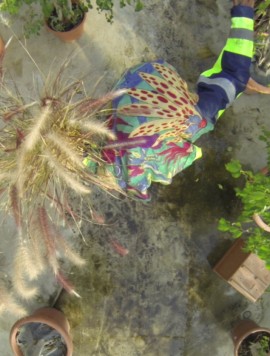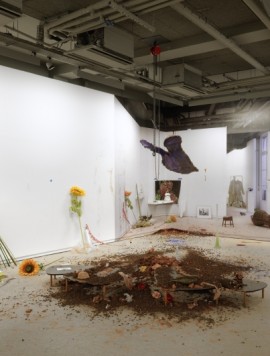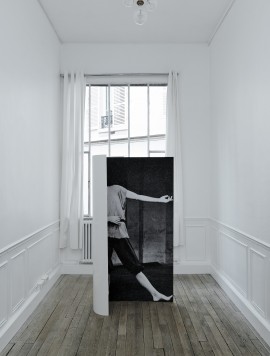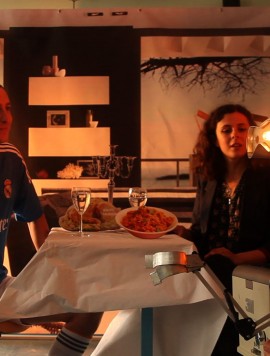Infinite scroll
Infinite scroll is a form of Internet navigation in which images load as you go along, creating the illusion of a page without end and generating a mixed sense of profusion and frustration. Data proliferation is the Web’s primary characteristic, and this is because the Web changes constantly, as source material is created, modified and deleted. The digital images that represent a massive proportion of this material can be infinitely reproduced and thus easily dissociated from their original context. Current methods of production, diffusion and consultation govern both the rapidity of their appearance on the screen and their ephemerality, making their viewing and storage a never-ending activity. This overabundance is so glaringly obvious in infinite scrolling that you have the feeling of being at the core of a nebulous, expanding universe.
More slowly, and on a different scale, this exhibition experiments with various freeze frames as part of the exploring the presence of images today and their modes of persistence. The opening exhibition by John Smith brought back the structured brought back the structured, historical, codified nature of moving image processes, enabling the viewer to grasp the construction of illusion and at the same time to take a certain pleasure in going along with it.
In their kinship with John Smith—with his mix of extreme lucidity and a predilection for the tricks of illusionism— the five artists in this exhibition have dropped a lot of the old reflexes regarding the status of the image, beginning with the original/copy polarity. They reject, too, any notion of sequence as to the image and its documentation—their work produces its own documentation, retaining the tangible signs of its creation, exhibition and dissemination—as well as any ranking either of individual media (including photography, Photoshop, photocopy, scan, drawing, sculpture, installation) or of “old” and “new” media (print, digitisation, exhibition, TV, cinema, the Internet and so on). These practices and their breaking down of compartment walls are not the whole story: the artists are working a transmedia vein, accumulating vehicles of expression, emphasising fragmentation, concurrency, interconnection and process as opposed to the finished—the new, unique, autonomous—image, while at the same time remaining fully aware of their historicity and specificity.
Their work is shot through with images whose replicas, traces or snippets can coexist in several different places at once: crossovers that are forms of remediation,1 a term used here by Jérôme Dupeyrat in referring to documentation céline duval and to images “perceived via a medium not initially theirs” in which they are redirected towards forms different from their original ones. In the course of these displacements the images preserve traces of their passage from one medium to anothe —traces of material differences. This brings with it a transformation, however minor, with their manipulation giving rise to margin for error, grey areas, a certain loss of definition, cropping, bent corners, alteration of mass, mistaken attribution, changes of name, etc. These worn or blurred images bear the signs of computer processing, the marks of successive reproductions—which is one way for artists to document the processes of making them. If there seem to be losses incurred in all these comings and goings, there are gains as well, the images being revitalised at the same time as they are impaired.
To displace is also to distort, as Sándor Ferenczi wrote in a letter to Freud in 1913, although referring to texts rather than images: “We might well lend the word [distortion] the double meaning to which it has a claim . . . It should mean not only ‘to change the appearance of something’ but also ‘to put something in another place, to displace’. Accordingly, in many instances of textual distortion, we many nevertheless count upon finding what has been suppressed and disavowed hidden away somewhere else, though changed and torn from its context.”2 It is these processes of distortion of images in their passages from one vehicle to another, one medium to another, one context to another, that the artists of “Infinite Scroll” render visible, using this reproducibility and circulation through history and space as a means of ensuring their persistence. These displacements are also ways of detecting, above and beyond informational and representational content, what stands up in an image: what lives on of its historical and affective charge.
Émilie Renard
Translated by John Tittensor
1. This concept is developed by Jay David Bolter and Richard Grusin in Remediation: Understanding New Media, Cambridge MA, MIT Press, 1999.
2. Sándor Ferenczi, letter to Sigmund Freud, 23 June 1913, quoted in Richard J. Bernstein, Freud and the Legacy of Moses, Cambridge, Cambridge University Press, 1998, p. 15.
around the exhibition
-
14/02/2014
From 4 pm to 6 pm
“Opera-Archipelago: pagan dances and critical bodies” with the Afro Carribean Jo’School, Elsa Dorlin (philosopher), Ana Pi (dancer) and Fannie Sosa (sociologist and performance artist).—
Salle Joséphine Baker
Meet at La Galerie at 3.30 pm -
07/03/2015
From 2 pm to 7 pm
Eastern Art Trail #19. An art excursion through eastern Paris, from Le 116 (Montreuil) to the Maison Populaire (Montreuil) and La Galerie.
—
Booking :
resa@parcours-est.com
or +33 [0]1 43 60 69 72
Free -
21/03/2015
From 4 pm to 6 pm
“Opera-Archipelago: fraught voices, lost bodies” with Maxime Cervulle (information and communication science theorist), Romuald Fonkoua (teacher of Francophone literature) and Julien Marine (countertenor).—
The auditorium at the Roger Gouhier media library. Meet at La Galerie at 4 pm






